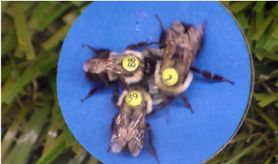The effect of the dispersion of rewarding and rewardless flowers on visitation and constancy by bumblebees (Bombus impatiens)
DOI:
https://doi.org/10.26786/1920-7603(2018)14Abstract
Deceptive pollination strategies, in which plants rely on animal pollinators but provide no benefits to their pollinators, have evolved many times in angiosperms. However, the conditions that favour deceptive pollination strategies over mutualistic strategies are poorly understood. One factor that may be important for the success of deceptive strategies is the plants’ dispersion in relation to co-flowering, rewarding species. We compared pollinator behaviour across two artificial environments, one in which a rewardless species was mixed with a rewarding species and one in which the two species occurred in contiguous patches. Bumblebees both encountered and visited rewardless flowers more often when they were mixed with rewarding species. However, the rate of switching was also higher under those conditions, which could result in higher rates of interspecific pollen transfer. The environmental conditions most favourable to deceptive pollination strategies may vary depending on the vulnerability of the plant species to interspecific pollen transfer.

Downloads
Published
How to Cite
Issue
Section
License
Copyright (c) 2018 Emma J Katz, Carla J Essenberg

This work is licensed under a Creative Commons Attribution 4.0 International License.
JPE is an open access journal which means that all content is freely available without charge to the user or his/her institution.
Authors who publish with this journal agree to the following terms:
1) Authors retain copyright and grant the journal right of first publication with the work simultaneously licensed under a Creative Commons Attribution License that allows others to share the work with an acknowledgement of the work's authorship and initial publication in this journal.
2) Authors are able to enter into separate, additional contractual arrangements for the non-exclusive distribution of the journal's published version of the work (e.g., post it to an institutional repository or publish it in a book), with an acknowledgement of its initial publication in this journal.
3) Authors are permitted and encouraged to post their work online (e.g., in institutional repositories or on their website) prior to and during the submission process, as it can lead to productive exchanges, as well as earlier and greater citation of published work (See The Effect of Open Access).
To assure a broader targeted audience, content will be included into databases (such as EBSCO) and directories (such as DOAJ).











